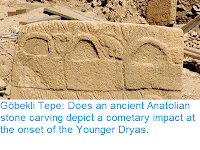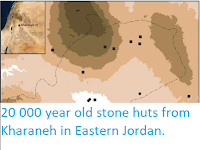During the Epipalaeolithic (between 23 000 and 11 500 years ago) hunter-gatherer populations around the Eastern Mediterranean began to build the oldest dwelling structures that we are aware off, beginning with plant-based huts that were probably only temporary structures to begin with, and developing to permanent stone-structures by the final Natufian phase of the period (14 500-11 500 years ago). As the earliest known purpose-built Human structures, the early Epipalaeolithic huts have been studied by archaeologists for some decades, with comparisons being made to those made by more recent hunter-gatherer populations in the African Kalahari Desert and Central Australian Desert, areas which are climatically similar to the modern day environments in Israel and Jordan, where these remains are found. However, the huts were constructed during the Late Pleistocene, when the climate was much cooler than it was today, with the environment where the Epipalaeolithic hut-builders lived likely to have had a cold temperate climate, similar to northern Europe or North America today, which requires some thinking of the nature and purpose of these huts.
In a paper published in the Journal of Archaeological Anthropology on 30 March 2018, Monica Ramsey of the McDonald Institute for Archaeological Research at the University of Cambridge, Lisa Maher of the Department of Anthropology at the University of California, Berkely, Danielle Macdonald of the Department of Anthropology at the University of Tulsa, Dani Nadel of the Zinman Institute of Archaeology at the University of Haifa, and Arlene Rosen of the Department of Anthropology at rhe University of Texas at Austin, present an analysis of phytoliths (silica fragments produced by plants) recovered from Kharaneh IV an Early Epipalaeolithic site in the Azraq Basin in Jordan.
Phytoliths are produced by plants as a way of handling silica absorbed with water from the soil. Most plants produce phytoliths to some extent, but Monocotyledons, such as Grasses and Palms, which utilise phytoliths both as structural support and a defence against herbivores (silica phytoliths quickly wear down the teeth of animals which lack specific adaptations to deal with them), produce phytoliths which can often be used to identify the maker to genus or even species level.
The Kharaneh IV site was also discovered in the 1980s, prior to which it was covered by wetlands, that were lost due to heavy water withdrawal to supply the growing city of Amman. The site is large, covering about 21 000 m², and about 1.5 m deep, and is thought to have been first occupied about 20 000 years ago, with continuous or intermittent occupation continuing for several thousand years. As well as the hut structures the site has yielded an underfloor burial, numerous ground stone tools, bone artifacts, and marine shell beads. Three hut structures (Structures 1, 2, and 3) examined at this site have been attributed to the earliest Epipalaeolithic. These have yielded a range of tools, bones and shells, which appear to have been left on the ground then covered over by a new floor.
Location map of Kharaneh IV and the location of other Epipaleolithic sites in the Azraq Basin. Ramsey et al. (2018).
Ramsey et al. took sediment samples from several locations from Structure 1 at Kharaneh IV and analysed them for phytolths. These were then identified under a light microscope. They found that a high density of Grass and Sedge phytoliths in areas of the site associated with both the floor of the hut and its superstructure, though the floor deposits had a higher density of Sedges, which they suggest is an indication that the floor of the hut was covered by Sedge material, either as a loose covering or as woven mats. Such a floor covering would make sense in the presumed cool climate of the Late Pleistocene, and is known to have been used by more recent hunter-gatherer groups living in similar climates, such as the Nunamiut people of northern Alaska. It would also help to explain the high number of cultural objects (tools, beads etc.) found at the site, as these are more easily lost where there is a loose floor covering.
The sediments associated with the superstructure of the hut were found to contain a high proportion of phytoliths derived from Reeds (Phragmites sp.), which Ramsey et al. take as an indication that reeds were used in the construction of the hut. They suggest that, rather than resembling a brush hut from Southern Africa or the Australian interior, the hut may have more closely resembled the structures made by the peoples of the Great Basin of North America (most of Nevada, Utah and Oregon, plus parts of California, Idaho and Wyoming), in which a structure was made from erect wooden poles, then pulled together at the top with a series of woven Willow rings, leaving a smoke hole at the top. This basic superstructure could then be covered with a range of secondary materials, such as bundles of Grasses tied directly onto the structure (thatch) or a variety of woven mats (often several layers of matting, with a waterproof outer layer and insulating layers inside).
See also...
Phytolith microfossils from Kharaneh IV, Structure 1. (a) Sedge cones; (b) Grass husk; (c) stacked keystone bulliforms (cf. Reed leaves); (d) Sedge cones; and (e) Sedge cones (side view). Ramsey et al. (2018).
The sediments associated with the superstructure of the hut were found to contain a high proportion of phytoliths derived from Reeds (Phragmites sp.), which Ramsey et al. take as an indication that reeds were used in the construction of the hut. They suggest that, rather than resembling a brush hut from Southern Africa or the Australian interior, the hut may have more closely resembled the structures made by the peoples of the Great Basin of North America (most of Nevada, Utah and Oregon, plus parts of California, Idaho and Wyoming), in which a structure was made from erect wooden poles, then pulled together at the top with a series of woven Willow rings, leaving a smoke hole at the top. This basic superstructure could then be covered with a range of secondary materials, such as bundles of Grasses tied directly onto the structure (thatch) or a variety of woven mats (often several layers of matting, with a waterproof outer layer and insulating layers inside).
Northern Paiute cattail house. Photograph by Mary Freeman, Stillwater, Nevada, ca. 1900. Libraries Special Collections/University of Nevada, Reno in Ramsey et al. (2018).
See also...
Follow Sciency Thoughts on Facebook.









